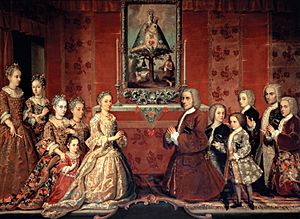Upper class facts for kids
The upper class is a term used in sociology, which is the study of how people live together in groups. It describes the group of people who are at the very top of a society. Members of the upper class often have a lot of power and control over important things like resources and government rules in their area.
Contents
What is the Upper Class?
The upper class is usually made up of families who have a lot of wealth (money and valuable things) and social standing. This group often includes people who own large businesses, have inherited a lot of money, or hold very important positions in society. They are sometimes called the "elite" because they are a small, powerful group.
Who Belongs to the Upper Class?
People in the upper class often have a lot of money, but it's not just about how much they earn. It's also about their family history, their education, and their connections to other powerful people. For example, they might go to special schools, live in large homes, and have a lot of influence in their communities.
How Does the Upper Class Influence Society?
Because of their wealth and connections, members of the upper class can have a big impact on how a country is run. They might influence governmental policy (the rules and laws made by the government) or control important resources like land, factories, or banks. This influence can shape decisions that affect everyone in society.
History of the Upper Class
Throughout history, there have always been groups of people at the top of society. In older times, this might have been kings, queens, nobles, or very wealthy landowners. For example, in the Spanish Empire's colonies in America, the upper class was often made up of Europeans and people born in America to Spanish parents. These groups were very influenced by European styles and ideas. Over time, the way people become part of the upper class has changed, but the idea of a top social group remains.
Related pages
Images for kids
-
Ball in colonial Chile by Pedro Subercaseaux. In Spain's American colonies, the upper classes were made up of Europeans and American born Spaniards and were heavily influenced by European trends.
-
The upmarket Harrods department store in London, 1909
-
First edition dust cover of Edith Wharton's 1920 Pulitzer Prize-winning novel The Age of Innocence, a story set in upper-class New York City in the 1870s
See also
 In Spanish: Clase alta para niños
In Spanish: Clase alta para niños





